
Northern Singlespike Sedge
Carex scirpoidea subsp. scirpoidea
Also Known As - Canadian Singlespike SedgeWatering:
Minimal
Hardiness Zone:
Flowers:
Flowers
Sun:
Sun
Leaf:
Yes
Growth Rate:
Low
Drought Tolerant:
Yes
Care Level:
Medium
watering
Rocky Mountain Sedge should be watered once a week with approximately 1 inch (2.5 cm) of water during the growing season. Be careful not to overwater, as too much water can lead to root rot. During cooler months, water less frequently (around every 2 to 3 weeks). Water the base of the plant, avoiding wetting the foliage to help prevent fungal or other plant diseases. Do not fertilize.
sunlight
Rocky Mountain Sedge (Carex saximontana) prefers full sun but can tolerate partial shade. It needs at least 6 hours of direct sunlight each day in order to thrive. While the plant performs best in the summer months when it receives maximum sunlight, in the winter it can do well with reduced sunlight. As temperatures start to cool, Rocky Mountain Sedge should receive no more than 4-5 hours of direct sunlight each day and should be protected from strong winds.
pruning
Rocky Mountain Sedge should be pruned in the fall or late summer, when the plant has gone dormant. When pruning, the goal should be to maintain the natural shape of the plant while removing any dead, diseased, and damaged branches. If needed, any branches that are overcrowding the plant can also be pruned off. Be sure to make clean pruning cuts close to the branch collar and to remove any old foliage that can harbor disease.
